Congratulations also to Team Stefanie Lawton for their win and Trials spot. They played a fantastic final game, with Stefanie making two key doubles in the second and fourth end to hold their opponent, Team Jennifer Jones featuring Kaitlyn Lawes as skip, to a pair of singles. She was also supported by conservative calls during the 9th end when, down one without hammer, Lawes, decided to play for a blank by continuing to hit and roll rather than draw around the centre guard. Stefanie had a strange call herself in the 6th end when, up two without hammer, she sits one on the button wide open. There is a corner guard covering second shot in the full twelve foot, belonging to Lawes.
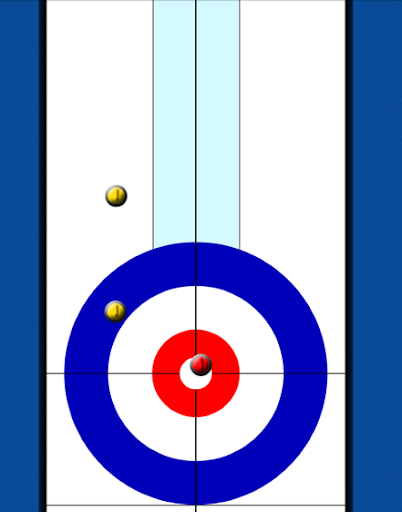
Lawton is Red
Stefanie thinks at first of trying to pick out the Lawes stone, but then decides to play a straight peel on the guard. It would be highly preferred that she play either a guard on her shot stone or draw to sit second. By peeling, she is essentially conceding a deuce. However, perhaps Lawton is simply trying to set up a cross house double, which she almost makes on her last. Luckily for Team lawton, Kaitlyn hits and rolls out on her open hit attempt for two and has to settle for one, leaving her down one without hammer.
Some other tidbits from the event:
Mike Harris never had it so good
Team Mike McEwen was shown on TSN 6 times per my counting, and if they had won their semi-final match-up, it would have been 7 televised draws for a team that has yet to make it to a Brier. Team McEwen has been in the televised spotlight with their many Grand Slam appearances as well. Contrast their fame with the anonymity of Mike Harris, with then third Richard Hart (who joined us on our recent podcast,...oh, ok, I said I'd stop). They had no such national exposure back in the early 90s when they couldn't break out of Ontario. Similar to McEwen who has lost the Manitoba final 3 years in a row, Mike and Rich lost 2 provincial finals in Ontario (1992 and '93), but were virtually unknown outside of the curling community in Eastern Canada and amongst the top traveling teams of the day. The 1998 Olympics changed all that and gave Mike the opportunity to work in the booth for CBC and now Sportsnet. A location he will be joined in by Richard Hart during next weeks' Grand Slam. I'm not expecting this type of male bonding magic, but hopefully it comes close.
Epping's call in the 9th
Against Mike McEwen, game is tied in the 9th end and John Epping does not have the hammer. On third Scott Bailey's first shot, he decides to draw into the pile of rocks in the four foot:
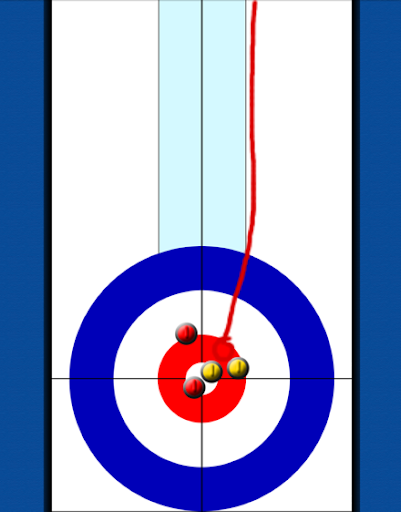
Epping is Red
Much better to throw a centre guard here and force Mike to throw a peel. At this stage he cannot risk a deuce or a blank. I suspect Mike was glad to see this call. Eventually John will have to play into the rings, and I expect he was concerned Mike would come in earlier instead of peeling, but I feel he should have waited until his first or last shot before making this call.
Those Team McEwen mustaches rival those of the Village People (can you tell which is a curling team and which is a world famous pop act who made white people dance with their hands above their shoulders?):
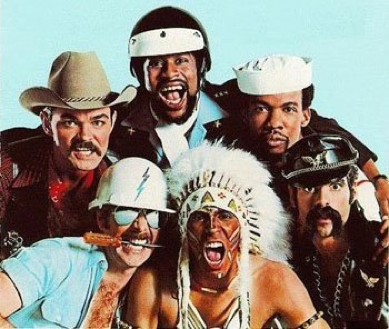

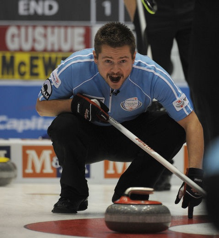
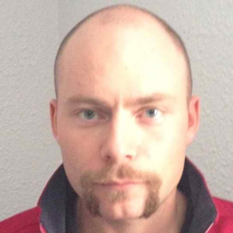
McEwen versus Martin:
An incredible first end, with rocks everywhere and Mike facing the potential for disaster. Everyone knows how Martin is nearly unbeatable when they score two in the first end. Mike smartly decides not to play runbacks and instead calls draw shots around the centre. Kevin plays along and eventually Mike makes a fantastic big weight shot on his last, leaving Martin sitting one. Kevin has a chance to make the granite fly but he racks on the guard, so we will not find out if more than two was possible.
Martin makes a great roll in the second, avoiding a possible two or three by McEwen. Instead, Kevin steals one and McEwen has to test the position of "down two with hammer to Martin and 8 ends remain".
McEwen quickly takes two and steals two, and eventually wins without much drama.
The Finals
Stoughton vs Howard for a Trials spot. Jeff's team needs to win to get a spot. Unnlike in years past, losing to a team which has already qualified (like Howard) does not give them the automatic berth. Adds a little intensity to the contest and you can tell by Jeff's cautious play early in the game. He chooses to hit with their first rock, rather than throw up a corner guard (a more common play). Unfortnately, lead Mark Nichols flashes on his second shot and Stoughton is forced to an eventual single point. Mark will make up for this early mistake by playing fantastic (88%) the rest of the way. To add a little math, by missing that shot, Mark needed to be 66/72 (based on 4 point scoring system) on his remaining 18 shots in order to hit 88%.
Stoughton steals in the second but is in trouble in the third end. Jeff manages a couple of freezes on skips rocks and is able to force Howard to one, crisis avoided. He now leads 2-1 with hammer.
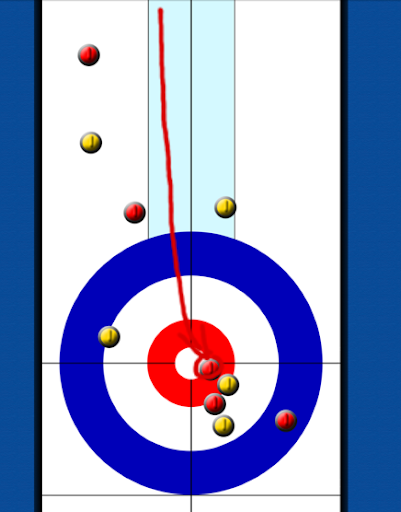
Stoughton is Red
In the 8th end, Stoughton has hammer tied 3-3. Glenn places his first rock in the rings and Jeff chooses to hit it, rather than put up a corner guard (similar to the first end). After Howard nose hits, Jeff calls for the corner. Russ mentions that this looks strange but, if Jeff prefers to play cautious, it's a clever strategy. Jeff doesn't allow Glenn to put up a "free-guard zone" center guard and force the play to the middle. This increases the possibility of a blank and gives Jeff the ability to play a more conservative end. We can only speculate if this would have been the same call in a game where an Olympic Trails spot was not on the line. Of note, Howard's third Wayne Middaugh actually noses a peel on his first attempt, something he may not have done more than 3-4 times since 1996 (this is what's called a "speculative" stat, in that I really have no idea, he's just know for throwing these well).
In the 9th end, still tied 3-3, Jeff throws their first stone out to the wings, rather than drawing around the center guard. This eventually puts Howard to a decision on his second Brent Lainge's final shot of the end (even has a 90 second time out!).
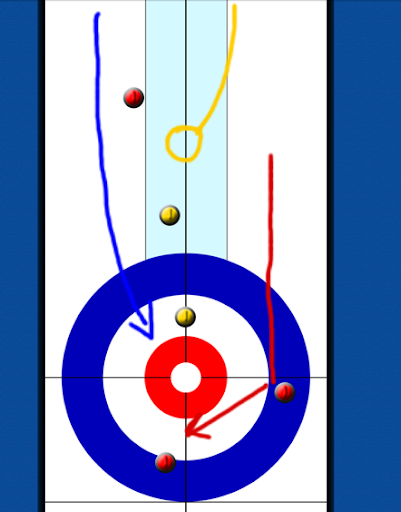
Stoughton is Red
Team Howard (and Brother Russ in the booth, drawing nearly as good on his telestrator as I have) discusses the option of a hit and roll (red line above), a guard (yellow) or the wide outturn draw (blue). You can make a case for all of these but I think the long guard may have proven better in the long run. As it turns out, Glenn calls the hit and roll and ends up in a position for a possible force but Wayne hits and rolls out when attempting to count two. This presents an interesting example of how playing out to the side has forced Jeff's opponent to consider play away from the center and keep the end more open for several options later. I like the way Stoughton has (both here and throughout the game) placed rocks to force his game plan rather than be forced into Glenn's. Hitting on leads first rock rather than placing a guard, for example, as discussed earlier.
Skips rocks and Glenn is looking at an open hit of the Stoughton rock in the side of the house or a draw around a corner guard.

Stoughton is Red
Wayne mentions the guard is too long to draw behind (the correct call if the gaurd was better positioned) so he chooses to hit the Stoughton stone in the 12 foot, rolling towards the centre. Jeff then rolls towards the guard, giving Glenn a chance on his final shot to force Jeff to one rather than blank. Glenn looks at a freeze versus a hit and roll behind the long guard covering a sliver of the four foot. He makes it perfect but Jeff still has enough room to make the shot of the game, a double and roll out for the blank by coming across the face, barely sneaking by the guard.
In the 10th, Nichols makes ticks on his first two. On Howard third Wayne Middaugh's second shot, they throw behind the corner left by the second tick shot. Stoughton third Jon Mead peels, Glenn puts the guard back, then a discussion of where to place Jeff's next shot.
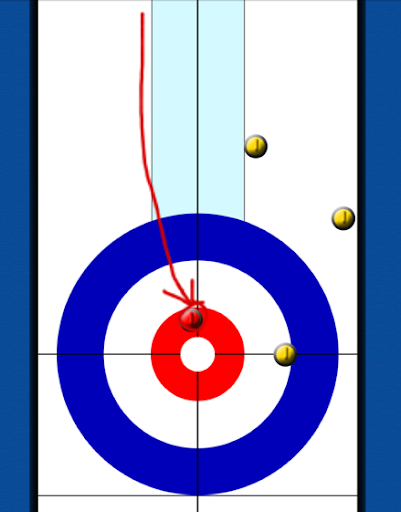
Stoughton is Red
They could peel, come around with a corner freeze. They discuss drawing back four foot, but instead draw top of the four foot (as shown above), resulting in a nose hit by Glenn giving them a simple hit for the win. Announcer Linda states "it really depends how you're feeling and I think today Jeff isn't really feeling the draw". I disagree. By placing his rock, Jeff gets to decide where Glenn has to play his rock, and can force it closer to where you want it. (Stoughton's team even discussed on air) the only reason to peel the guard would be if they want the inturn draw and the guard gets in the way. Having said that, perhaps Jeff did prefer to make a hit with his final shot and that's why he placed it where he did (with absolutely perfect draw weight).
For those readers who appreciate the math slant to my blog, you should check out Nate Silver's interview with Bill Simmons on Grantland.com.
G'Nite.




